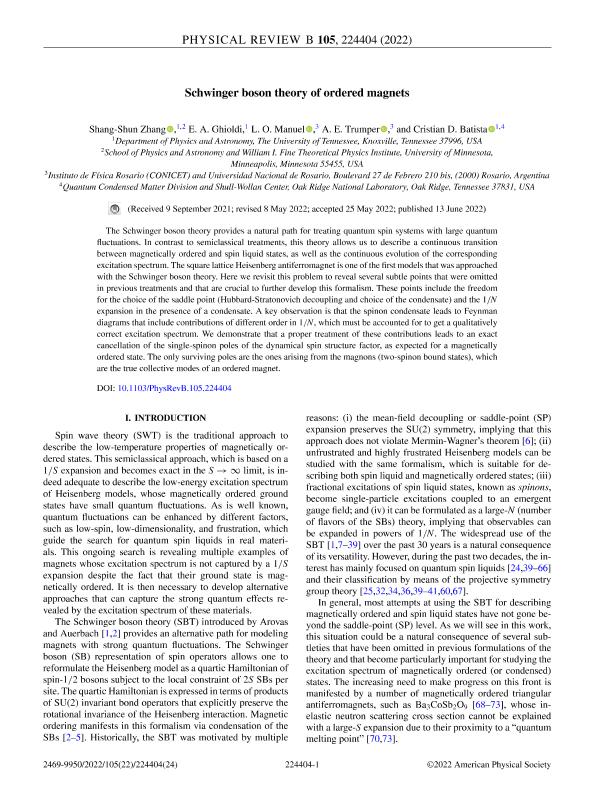Mostrar el registro sencillo del ítem
dc.contributor.author
Zhang, Shang Shun
dc.contributor.author
Ghioldi, E. A.
dc.contributor.author
Manuel, Luis Oscar

dc.contributor.author
Trumper, Adolfo Emilio

dc.contributor.author
Batista, Cristian D.
dc.date.available
2023-08-23T15:57:23Z
dc.date.issued
2022-06
dc.identifier.citation
Zhang, Shang Shun; Ghioldi, E. A.; Manuel, Luis Oscar; Trumper, Adolfo Emilio; Batista, Cristian D.; Schwinger boson theory of ordered magnets; American Physical Society; Physical Review B: Condensed Matter and Materials Physics; 105; 22; 6-2022; 1-24
dc.identifier.issn
2469-9969
dc.identifier.uri
http://hdl.handle.net/11336/209102
dc.description.abstract
The Schwinger boson theory provides a natural path for treating quantum spin systems with large quantum fluctuations. In contrast to semiclassical treatments, this theory allows us to describe a continuous transition between magnetically ordered and spin liquid states, as well as the continuous evolution of the corresponding excitation spectrum. The square lattice Heisenberg antiferromagnet is one of the first models that was approached with the Schwinger boson theory. Here we revisit this problem to reveal several subtle points that were omitted in previous treatments and that are crucial to further develop this formalism. These points include the freedom for the choice of the saddle point (Hubbard-Stratonovich decoupling and choice of the condensate) and the 1/N expansion in the presence of a condensate. A key observation is that the spinon condensate leads to Feynman diagrams that include contributions of different order in 1/N, which must be accounted for to get a qualitatively correct excitation spectrum. We demonstrate that a proper treatment of these contributions leads to an exact cancellation of the single-spinon poles of the dynamical spin structure factor, as expected for a magnetically ordered state. The only surviving poles are the ones arising from the magnons (two-spinon bound states), which are the true collective modes of an ordered magnet.
dc.format
application/pdf
dc.language.iso
eng
dc.publisher
American Physical Society

dc.rights
info:eu-repo/semantics/openAccess
dc.rights.uri
https://creativecommons.org/licenses/by-nc-sa/2.5/ar/
dc.subject
FRUSTRATION
dc.subject
ANTIFERROMAGNETISM
dc.subject
LARGE N
dc.subject
SCHWINGER BOSON THEORY
dc.subject.classification
Física de los Materiales Condensados

dc.subject.classification
Ciencias Físicas

dc.subject.classification
CIENCIAS NATURALES Y EXACTAS

dc.title
Schwinger boson theory of ordered magnets
dc.type
info:eu-repo/semantics/article
dc.type
info:ar-repo/semantics/artículo
dc.type
info:eu-repo/semantics/publishedVersion
dc.date.updated
2023-07-17T17:56:27Z
dc.journal.volume
105
dc.journal.number
22
dc.journal.pagination
1-24
dc.journal.pais
Estados Unidos

dc.journal.ciudad
New York
dc.description.fil
Fil: Zhang, Shang Shun. University of Tennessee; Estados Unidos
dc.description.fil
Fil: Ghioldi, E. A.. University of Tennessee; Estados Unidos
dc.description.fil
Fil: Manuel, Luis Oscar. Consejo Nacional de Investigaciones Científicas y Técnicas. Centro Científico Tecnológico Conicet - Rosario. Instituto de Física de Rosario. Universidad Nacional de Rosario. Instituto de Física de Rosario; Argentina
dc.description.fil
Fil: Trumper, Adolfo Emilio. Consejo Nacional de Investigaciones Científicas y Técnicas. Centro Científico Tecnológico Conicet - Rosario. Instituto de Física de Rosario. Universidad Nacional de Rosario. Instituto de Física de Rosario; Argentina
dc.description.fil
Fil: Batista, Cristian D.. University of Tennessee; Estados Unidos
dc.journal.title
Physical Review B: Condensed Matter and Materials Physics

dc.relation.alternativeid
info:eu-repo/semantics/altIdentifier/doi/http://dx.doi.org/10.1103/PhysRevB.105.224404
Archivos asociados
